In 2002, the Auburn Center for the Study of Theological Education published its first research report on seminary boards. That study, In Whose Hands?: A Study of Theological School Trustees, reported on the backgrounds of theological school board members, their views of the institutions they served, and their preparation for the tasks of governance.
Consider these dilemmas:
1. The board of a struggling seminary, the sole theological school of a small denomination, decides that the school must expand its base to survive. It elects a president from a different denomination and gives him a mandate for change. The faculty, hostile to the outsider from day one, refuses to cooperate, and the president reacts angrily. The board watches the conflict as if it were a tennis match. The battle escalates, and the faculty votes no confidence in the president. The board gives in to the faculty lobbying and fires the president.
2. Membership on the large board of a leading seminary is viewed as a prestige appointment, especially by graduates who are pastors of prominent churches. Over decades, expenses have been mounting and revenues declining, but legacy endowments have provided a cushion. Two presidents in succession have regularly assured the board that financial rearrangements would keep it secure. In 2009, a new president arrives. He discovers a large intractable deficit and learns that expendable funds that have kept the seminary solvent are now almost exhausted.
3. A small seminary on the verge of financial collapse learns that a college of its denomination is willing to adopt it. The presidents of the college and the seminary, old seminary classmates, see many advantages: the college offers survival to the seminary; the seminary restores some lost religious credibility to the college. The merger agreement has few details, but trust between the two presidents is deep and five seminary board members are to be added to the college’s board. The seminary board votes unanimously to merge. But when a new college president takes office, he replaces the seminary head and sets steep financial goals for the seminary, which again struggles to meet its financial commitments, much as it had prior to the merger.
These vignettes describe actual events in North American theological schools during recent decades. Readers who know the seminary world may think that they can identify the schools. If so, they may be both right and wrong. In this summary form, each of these tales of governance failure is not so far removed from the experience of several schools.
The research team has drawn several conclusions, which are detailed in the full study. This excerpt focuses on two:
- Theological schools have adopted many policies and practices recommended by experts on higher education governance.
- Theological schools continue to face major governance challenges. The baseline study from 2002 documented gaps and weaknesses in boards that made it difficult for them to play their part in achieving their institutions’ goals. Over the interval between that study and the present one, there have been at best modest gains in the problem areas identified.
How much power and autonomy do theological school boards have? Governance structures at theological schools are widely varied and becoming even more so: one-third of ATS member institutions are embedded in or partnered with another institution and do not have their own boards, and freestanding schools are governed in a variety of ways, including boards that have full trusteeship powers, boards with delegated powers from a church body or official, and boards or committees that are purely advisory. Figure 1 shows that different streams of religious tradition have different patterns of governance.
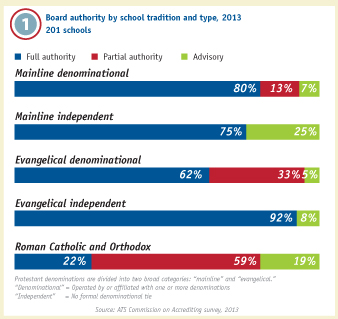
Although the majority of the boards of freestanding schools have full authority over their institutions, there is also diversity within that group. Some Protestant boards have only partial authority, with certain powers reserved to their denomination. Most Roman Catholic seminaries owned by dioceses are governed by a single church official, and while their boards may play significant roles, they have no legal powers. Roman Catholic schools owned by religious orders may have either partial- or full-authority boards.
The varieties of board structures are reflected in differing modes of board member selection. Only a minority of full-authority boards — less than one quarter — nominate and elect all their own members. The remainder have some or all of their boards designated by religious bodies. In addition, some have board members elected by faculty or alumni/ae associations.
Good policies and practices now in place
Considering the widely heterogeneous patterns of governance, it is somewhat surprising that large majorities of theological school boards have adopted practices recommended by board-serving organizations. For instance, many boards have embraced the practices of board education (sessions to inform the board about aspects of the school’s work or the context in which it operates), board self-evaluation, and retreats (extended meetings to strengthen communication between board members and explore topics of importance). Almost two-thirds of schools report that they have recently held a board retreat.
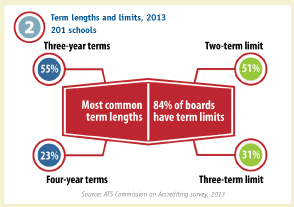 The most dramatic revision in traditional practices for some boards has been the institution of terms and term limits for board members. Over the past several decades, virtually all seminaries have instituted a system of terms for board members, so that membership is reviewed and renewed at regular intervals. As Figure 2 shows, a large majority limit the number of terms any board member can serve. Most often, limits of service are set at two or three terms of three or four years each in length. Longer service is possible, but most schools require at least a year to elapse before a board member who has served the full complement of terms can be re-elected.
The most dramatic revision in traditional practices for some boards has been the institution of terms and term limits for board members. Over the past several decades, virtually all seminaries have instituted a system of terms for board members, so that membership is reviewed and renewed at regular intervals. As Figure 2 shows, a large majority limit the number of terms any board member can serve. Most often, limits of service are set at two or three terms of three or four years each in length. Longer service is possible, but most schools require at least a year to elapse before a board member who has served the full complement of terms can be re-elected.
The norm of term limits has been applied to board chairs as well. About half of boards elect the chair annually, the other half every two or three years. Many permit renewal of the board chair’s term, for a total of five to nine years continuous service, but only after re-nomination at the end of each term.
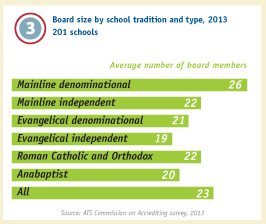 There are other indications that most theological schools try to keep up with best board practices. More than 90 percent routinely conduct evaluations of the president’s performance, with over three-quarters doing so annually or more often. All make provision for executive sessions. Further, the level of attendance at board meetings is reported to be high — 85 percent, on average. This may be the result of the widespread implementation of another good governance standard: reducing the size of large boards to a level at which members feel responsible to attend and participate in decisions. The average size of boards is now about 23, as Figure 3 shows. (The larger size of mainline Protestant and Roman Catholic boards reflects the larger numbers of advisory boards in those categories, since these tend to be larger.)
There are other indications that most theological schools try to keep up with best board practices. More than 90 percent routinely conduct evaluations of the president’s performance, with over three-quarters doing so annually or more often. All make provision for executive sessions. Further, the level of attendance at board meetings is reported to be high — 85 percent, on average. This may be the result of the widespread implementation of another good governance standard: reducing the size of large boards to a level at which members feel responsible to attend and participate in decisions. The average size of boards is now about 23, as Figure 3 shows. (The larger size of mainline Protestant and Roman Catholic boards reflects the larger numbers of advisory boards in those categories, since these tend to be larger.)
Persisting weaknesses and challenges
Has the adoption of good governance practices equipped boards to meet new and ongoing challenges to their institutions? Several areas of governance weakness were identified a decade ago. The current study revisited those findings.
Competence and expertise of board members
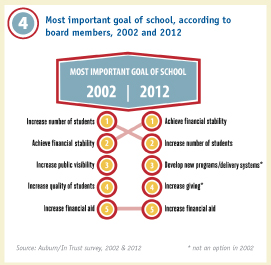 Board members were asked in 2002 and again in 2012 about the most important current goals of their institutions. As Figure 4 shows, the answers were similar across the years: Increasing the numbers of students, achieving financial stability, and increasing financial aid to the students were all highly ranked at both ends of the interval. Financial stability, the second highest-ranked goal in 2002, was understandably ranked first in 2012, just a few years after the major financial downturn of 2008. In 2012, two options newly added to the later survey were also highly ranked: increasing giving to the schools and creating new programs and program delivery systems.
Board members were asked in 2002 and again in 2012 about the most important current goals of their institutions. As Figure 4 shows, the answers were similar across the years: Increasing the numbers of students, achieving financial stability, and increasing financial aid to the students were all highly ranked at both ends of the interval. Financial stability, the second highest-ranked goal in 2002, was understandably ranked first in 2012, just a few years after the major financial downturn of 2008. In 2012, two options newly added to the later survey were also highly ranked: increasing giving to the schools and creating new programs and program delivery systems.
How well equipped are board members to guide their schools toward these goals? Board members’ self-assessments in 2002 showed that expertise was not closely matched to areas of need. As the light blue bars on Figure 5 show, the only topics on which the average self-rating by board members was more than “some” were planning and church-related matters (theology, denominational relations, and local church affairs). In 2002, church support for theological schools was waning, and this trend has continued, suggesting that board knowledge and contacts within church bodies have not made a significant contribution toward sustaining levels of direct support. At the same time, ratings on topics related to the areas of greatest need — finance, student affairs, marketing, and fundraising — were low.
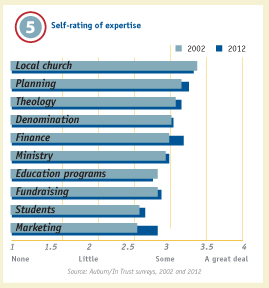 The 2012 survey shows a few encouraging changes over the decade. Self-ratings on important topics like marketing and finance are higher, as shown by the dark blue bars in Figure 5. Most of the change in other functional areas, however, is negligible. In fact, of the topics most relevant to the goals that board members identified as critical for their schools, only expertise in finance is rated higher, on average, than “some.”
The 2012 survey shows a few encouraging changes over the decade. Self-ratings on important topics like marketing and finance are higher, as shown by the dark blue bars in Figure 5. Most of the change in other functional areas, however, is negligible. In fact, of the topics most relevant to the goals that board members identified as critical for their schools, only expertise in finance is rated higher, on average, than “some.”
Of greatest concern are the low self-ratings of board members on fundraising. More than half of all theological institutions are struggling financially. Since 2006, headcount enrollments have been falling, and full-time equivalent enrollments, which are more closely correlated with tuition revenue, have been declining even faster. The market crash of 2008 cut into revenue from the endowments and reserve funds of those institutions fortunate enough to have such resources. With traditional revenue sources under stress, fundraising has become to the key to survival for a significant number of institutions. It was, however, one of the lowest-rated areas of expertise of board members. As Figure 6 shows, it was also one of the lowest rated areas of board performance, and board members’ ratings of their own performance in this area were lower in 2012 than in 2002.
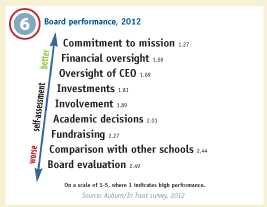
The 2012 survey asked about board members’ level of comfort with various aspects of fundraising, with results shown in Figure 7. The activities that require least personal contact — writing letters and providing names of prospective donors — are the most comfortable. Cultivation — spending time with prospective donors — is moderately comfortable; making telephone calls to donors and asking them for money is less so.
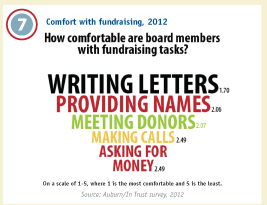 For many nonprofit and most private higher education boards, personal wealth ranks high among criteria used in selection of board members. Not so for theological schools. Figure 8 shows the distribution of board members’ income in 2012. More than one-third (35 percent), most of them clergy, had annual income of less than $100,000. Because most seminary board members are not very wealthy, it is not surprising that the median annual unrestricted operating gift was $2,000 in 2012 — an amount that falls well below the minimum gift that many other educational and nonprofit boards require. (Some board members made additional gifts. The median gift for restricted operating purposes was $1,000, but only 10 percent of board members made such gifts; the median gift for capital purposes was $5,000, with about one-fifth of respondents reporting making such a gift.)
For many nonprofit and most private higher education boards, personal wealth ranks high among criteria used in selection of board members. Not so for theological schools. Figure 8 shows the distribution of board members’ income in 2012. More than one-third (35 percent), most of them clergy, had annual income of less than $100,000. Because most seminary board members are not very wealthy, it is not surprising that the median annual unrestricted operating gift was $2,000 in 2012 — an amount that falls well below the minimum gift that many other educational and nonprofit boards require. (Some board members made additional gifts. The median gift for restricted operating purposes was $1,000, but only 10 percent of board members made such gifts; the median gift for capital purposes was $5,000, with about one-fifth of respondents reporting making such a gift.)
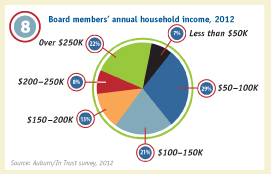
There are other signs that the fundraising needs of their schools are not as prominent for board members as they should be, given the financial condition of most institutions. Though three-quarters of U.S. theological school boards require board members to make a contribution as part of their board commitment, only one board in ten sets a minimum contribution level. (Canadian boards are different: two-thirds of them do not require a financial contribution, and none sets a minimum amount.) And only one-third of board members have named the seminary they serve in their will, a percentage that did not change between 2002 and 2012.
Uneasiness with the demands of institutional advancement is evident on other fronts too. Although board members’ ratings of the performance of chief executives is generally highly favorable, fundraising is the lowest-rated function of CEOs, and development officers are the lowest-rated of all senior administrators.
Diversity
Almost all theological schools seek racial and gender diversity at all levels, including on their boards or advisory committees. In general, women are as well represented on boards as they are on faculties in each major religious sector, but both boards and faculties lag behind the percentages of women students. Half the student bodies of mainline Protestant schools, for instance, are female, but just over one-third of faculty and board members are women. Roman Catholic institutions exhibit a similar pattern. The percentages of women students in evangelical seminaries are roughly twice the percentages of faculty and board members. Progress toward gender diversity over the last decade has been very slow or nonexistent.
The pattern for race resembles the pattern for gender. In 2012, 19 percent of board members and faculty and 38 percent of students were non-white. The average figures for board members (as well as for faculty and, to a lesser extent, students) are affected by concentrations of racial/ethnic minorities in some schools. The median percentage of racial/ethnic board members was only 13 percent, which means that half of all boards had racial/ethnic membership of 13 percent or less. Racial/ethnic representation in many theological schools, and on their boards, lags well behind representation in the wider population.
Critical engagement
In 2002, board members were asked a series of questions about board operations and relationships. The responses were highly positive, leading researchers to question whether board members were fully aware of the difficulties confronting many of their schools. The decade since that study has brought even more serious challenges and problems. Financial stress and enrollment downturns head the list of pressing issues.
In the fall of 2013, five years after the 2008 recession began, 50 percent of schools were still struggling with more than nominal deficits, according to the Association of Theological Schools (which defines “more than nominal” deficits as those of $250,000 or more). Beginning in 2006, overall enrollments began to fall at the rate of about one percent a year, a rate that has recently accelerated. In some sectors, the enrollment decline started sooner and has been steeper. (For more on this, see www.intrust.org/enrollmentresearch.)
 To test the impact of these adverse developments on attitudes toward board service and on perceptions of the adequacy of board performance, the 2012 survey posed some of the same questions as the survey conducted one decade earlier. Despite worsening conditions for almost all theological schools, Table 1 shows that board members expressed high levels of approval for all features of their board service about which they were questioned.
To test the impact of these adverse developments on attitudes toward board service and on perceptions of the adequacy of board performance, the 2012 survey posed some of the same questions as the survey conducted one decade earlier. Despite worsening conditions for almost all theological schools, Table 1 shows that board members expressed high levels of approval for all features of their board service about which they were questioned.
On one hand, these very high ratings are a sign that board members care about the schools they serve and want to do a good job. They hope — and they wish to believe — that their school is doing a good job. If administrative leaders provide mostly positive publicity (and seasoned observers who contributed to this study suggested that all too often this is the case), board members are rarely inclined to press beyond the positive reports to uncover evidence of problems and unmet challenges.
The data on board attitudes and performance self-assessment collected for the present study seem to indicate that questions researchers raised in the earlier study are even more pertinent now: Are board members sufficiently engaged in the strenuous and sometimes life-threatening struggles of their schools? Are they sufficiently critical of efforts (which in many cases have not been successful) to better the conditions of their schools?
Age and replacement
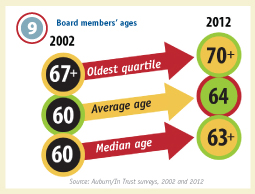 Seminary board members are much older than members of other educational and nonprofit boards. In 2002, half of theological school board members were 60 or older; only 36 percent of private colleges’, 30% of public colleges’, and 19 percent of other nonprofits’ board members fell into that age category.
Seminary board members are much older than members of other educational and nonprofit boards. In 2002, half of theological school board members were 60 or older; only 36 percent of private colleges’, 30% of public colleges’, and 19 percent of other nonprofits’ board members fell into that age category.
The average age of board members for theological schools — and indeed, for all kinds of institutions — has increased in the decade since that comparison was made. This is due primarily to the aging of the baby boomers who occupy many board positions. Figure 9 compares the 2012 respondents with those who replied in 2002. As Figure 10 shows, seminary boards have significantly more older members than do other nonprofit boards or private college and university boards.
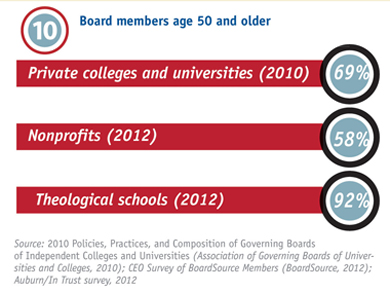 Advanced age brings with it certain advantages, such as long experience and potentially deep wisdom. (Elderly board members may also be prospects for bequests, which are usually the largest gifts made to theological schools, but 58 percent of board members 70 and older have not made provision for the seminary in their will.) However, most institutions that can be selective about whom they add to their boards seek those currently in positions of influence, those who have high current incomes, and some younger board members who can be groomed as replacements for older board leaders. Theological school boards, one-third of whose members were retired in 2012, have fewer board members in the age categories deemed highly desirable by other organizations.
Advanced age brings with it certain advantages, such as long experience and potentially deep wisdom. (Elderly board members may also be prospects for bequests, which are usually the largest gifts made to theological schools, but 58 percent of board members 70 and older have not made provision for the seminary in their will.) However, most institutions that can be selective about whom they add to their boards seek those currently in positions of influence, those who have high current incomes, and some younger board members who can be groomed as replacements for older board leaders. Theological school boards, one-third of whose members were retired in 2012, have fewer board members in the age categories deemed highly desirable by other organizations.
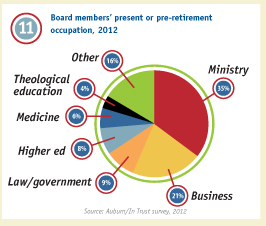
Whether or not younger board members are preferable, a preponderance of older members accelerates the need to locate their replacements. Forty-two percent of board members in 2012 said that they were ordained clergy, and 35 percent said that their primary present or pre-retirement occupation was some form of ministry. Many of these board members, some of whom are nominated or appointed by their denominations, will be replaced by other clergy. But, as Figure 11 illustrates, the majority of board members are in secular occupations, including business, law, higher education, and other professions whose members are courted by other organizations for board service. These are the occupations whose practitioners bring some of the expertise that theological school board members report is in short supply — finance, marketing, public relations, and fundraising — and whose contacts and compensation levels may orient them toward making major gifts and seeking donations from others.
How will persons from these sectors be recruited for service on seminary boards? Personal and family ties to theological schools have played a major part in attracting lay board members. More than one-third (36 percent) of the lay board members who responded in 2012 had either attended some seminary themselves (13 percent) or had a relative who had attended the school on whose board they were serving. That tradition may be difficult to sustain as the children of today’s church members increasingly switch denominations or faith traditions, or drop out of organized religion altogether.
Nor is it likely that today’s younger board members will be the board leaders and members needed in the future. An analysis of the youngest sector (“Millennial” and “Generation X”) was dominated by one type of board member. Two-thirds of them were graduates of the school they were serving as a board member (in contrast, half of boomers are such graduates). These young board members were more likely to be clergy and to serve on the boards of evangelical denominational seminaries as members nominated, elected, or appointed by the denomination. They were more highly educated than other board members, and they brought greater racial diversity, but they were significantly more likely to say that their expertise is in theology and church affairs and less likely to claim expertise in other areas that theological school boards badly need. But even if they did bring a wider range of backgrounds, skills, contacts and wealth, they would not be likely to be the board members of the future: Most were designated for board service by religious groups, which often have some kind of rotation system in place for board designees.
Patterns of recruitment
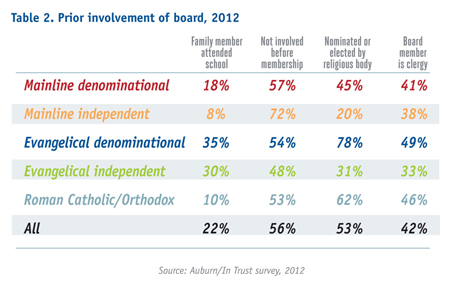 Patterns of recruiting board members varied by the religious family of the school and its relationship to religious bodies. Table 2 displays some of the differences. Evangelical institutions were more likely to depend on family relationships to identify board members. One-third of the board members of evangelical denominational schools — many serving small denominations — were related to a graduate of the school, and these schools’ board members are very likely to have been nominated or elected by a religious body. (To a lesser extent this is true for Roman Catholic boards as well: Many are advisory; others are related to religious orders that appoint members to their boards.)
Patterns of recruiting board members varied by the religious family of the school and its relationship to religious bodies. Table 2 displays some of the differences. Evangelical institutions were more likely to depend on family relationships to identify board members. One-third of the board members of evangelical denominational schools — many serving small denominations — were related to a graduate of the school, and these schools’ board members are very likely to have been nominated or elected by a religious body. (To a lesser extent this is true for Roman Catholic boards as well: Many are advisory; others are related to religious orders that appoint members to their boards.)
By sharp contrast, a large majority of those recruited to serve on the boards of mainline Protestant seminaries had no prior contact, personal or familial, with the institution, and were less likely to be appointed by an authority outside the board itself.
In conclusion
Despite wide variations in the governance arrangements in U.S. and Canadian theological schools, there has been remarkable uniformity in the adoption of policies and practices recommended by those who advise nonprofit boards. Some of these strategies, such as term limits, are safeguards against the abuse of authority or neglect of duty that may occur if power becomes concentrated in one person or sector. Others, like board education, provide equipment for the tasks of governance. Closer attention to matters such as well-defined process, power dynamics within the board, orientation of new board members, education of the whole board, and self-scrutiny have all contributed to making boards more functional.
At the same time, though, there has been only modest progress in addressing the substantive weaknesses of seminary boards: underperformance in some of the areas of the schools’ greatest needs, lack of critical engagement with the school’s most serious problems and challenges, and inadequate racial, gender, and age diversity. Most of these issues are related to the composition of boards. Many boards have only partial control or sometimes no control over who their members will be, which makes the recruitment of the board members needed to fill representational gaps difficult or impossible. But even those boards that can select some or all of their membership encounter obstacles. The population of church members is aging; young members are hard to find. The prestige of religious institutions has diminished and with it their social impact. Persons who have the background, expertise, influence, and resources that charitable organizations need are in high demand.
In the next issue
Good governance is possible: Some schools have established highly effective governance systems. Because of the wide variety of governance structures in theological schools, the practices of these “good governance” schools cannot be applied directly in every situation; nevertheless, lessons from the case studies and suggestions of steps that theological schools can take to remedy weaknesses can be derived from the research results.
Part 2 of this article, in the next issue of In Trust magazine, covers the lessons learned from case studies and examines the role of the chief executive, in concert with faculty and other administrators, in theological school governance.
The full report on this research, Governance That Works: Effective Leadership for Theological Schools, will soon be available online at https://auburnseminary.org/report/governance-that-works/.